What to Put on a Resume in 2026 [7+ Job-Winning Sections]
Updated on 12/17/2025

Choosing what to put on a resume can be a real struggle even if it’s not your first time writing a resume.
After all, not every resume has the same sections. Depending on your experience level & where you’re applying, your resume might look completely different.
For example, you always need to include your contact information, but the resume objective can be very situational.
The content that goes inside each section can differ as well, depending on whether you are applying for a job, an internship, or for a Ph.D. program.
So, the key here is to tailor your resume content to the job you’re applying for. As long as you mention the right things on your resume, you’re bound to land a job you’ll love.
Read on to learn what to put on your resume, depending on where you’re applying. We’ve also added a little extra section at the end of the guide on what NOT to include under any circumstance.

What to Include in a Resume To Land The Perfect Job
The most important contents to include on your resume are:
- Contact information
- Resume summary or objective statement
- Professional Experience
- Skills/Certifications
- Education
- Other Important Sections
- Tailor Your Resume to The Job Description
In this guide, we’re going to go through all of them one-by-one and teach you what to write in each section.
1. What Contact Information Should Your Resume Have?
A great resume would contain the following contact information in the right order:

Full Name - The generally preferred format is Name, Last Name
Right under the name, you should include your:
Professional Title - this should always mirror the job position you are applying for.
Let’s say you are applying for a “front-end web development” position but your professional title says “Junior Data Scientist”.
Whoever picks up your resume will most likely discard it thinking that you are either overqualified for the position or your resume is in the wrong pile.
Professional Email Address
Your email should be professional and not something you created back in primary school. (“smrtblonde77@gmail.com” or “I_love_elijah_wood_foreva@hotmail.com”)
If you don't have one, make an email specifically for your career and make it something along the lines of [name] [last name] @ email.com
Check out our guide on how to email your resume to an employer for more tips!
Phone Number - If you are applying for a job outside your country, make sure to include your country code as well. If you have a US phone number, for example, you’d add (+1) in front of the number 555 555 5555.
Here’s an example of how this would look exactly.

So far so good. However, you can notice how there is a lot of valuable empty space for you to add more eye-catching information.
Aside from the basic contact information, you should also put on your resume links to your social media handles and/or personal websites.
Relevant Social Media Handles
Here are some common social handles you could include that can help you get hired:
LinkedIn
Many companies nowadays ask for a Linkedin profile when you apply for a job.
Your chances of getting hired will be greater if you keep your LinkedIn profile just as up-to-date as your resume.
Twitter
In very specific cases, you can also include your Twitter profile (if it’s somehow relevant to the job).
Some marketing jobs ask for an existing social following, for example. In others, you could use it to display your witty, under-20-characters writing skills.
Quora
Quora questions and answers cover a wide range of business topics nowadays.
Are you an expert at giving business advice with 100+ answers on the topic? You can show your authority by linking your Quora page.
StackOverflow
Mainly relevant for developers, coders, computer scientists.
Having a very active Stack overflow profile can give you a big boost if you code.
Github
Only for developers, coders, data scientists, etc.
Github is a great way to showcase your projects. Whether it’s a website you developed, or a mobile game, make sure to include it!
Medium
Freelancers, writers, bloggers, and entrepreneurs.
A rich medium profile can help you showcase your writing skills and personality before even getting to the interview or trial task.
Make sure to only put the relevant social media handles on your resume. If you are applying for a software development position, for example, your StackOverflow profile will be more relevant than your Twitter account.
URL to your personal website/channels
Here are some typical examples of what you could include:
- Personal website - Include a link to your personal website if you have an established online presence. Don’t include it if it’s just a literal HTML copy of your resume. No one will want to read the same content over again.
- Personal blog - Only include this if it is relevant to the job you are applying for. For example, if you have a blog that positions you as an expert in your field. A personal blog on meditation and unlocking the power within won’t mean much when applying for an accounting position.
- URL to your personal portfolio - For web designers, illustrators, painters, photographers, etc...
- Youtube channel - A channel containing videos of you explaining quantum economics can be a great thing to put on a resume if you are applying for a job in the field of economics.
So in the end, your contact information section would look something like this:

This example was made with a Novorésumé template, and it took us less than 15 seconds! Give our online resume builder a try - we’ll save you from the hassle of manually formatting your resume!
2. Make the Right First Impression With a Resume Summary or Resume Objective
Nowadays, it takes less than half a second for someone to swipe left and discard your entire worth on Tinder.
Luckily, when applying for a job, you won’t be swiped left based on how you look. You’ll get discarded if you fail to catch the HR manager’s attention.
On average, it takes an HR manager or recruiter around 6 seconds to decide whether your resume goes on the discard pile or not.
That’s why you want to leave a good first impression. Just like you did with that Tinder profile photo you uploaded from the time when you still had abs!
When writing a resume, the best way to achieve that is by writing a killer resume summary or objective.
How to Write a Resume Summary
A resume summary is a 2-3 sentence summary of your entire professional career. If you have more than 2 years of work experience, you’d opt for the resume summary instead of an objective (we’ll explain why in a bit!).
The core structure of a resume summary should contain the following information:
Jobs and years of experience
- Senior front-end developer with 10+ years of experience in Angular and ReactJs
Relevant achievements and responsibilities
- Specialized in developing e-commerce solutions following agile development principles.
What you are looking for. Your goal.
- Seeking a position as a front-end lead developer at a startup company

To make sure your resume summary is memorable, make sure to mention how your previous experience on motivation will be beneficial to the company you’re applying for. You should include the following information:
- What can you do for them?
- How will your previous experience fit in the company’s current environment?
- How can you help their company grow while pursuing your own personal goals simultaneously?
How to Write a Resume Objective
Just like a resume summary, your resume objective is also max 2-3 sentences. Rather than describing your work experience, the resume objective focuses more on your motivation for applying for a specific job.
If you're a professional with several years’ worth of work experience, you should always stick to the resume summary. You're much more likely to sell yourself with your experience, rather than motivation.
If you're one of the following, though, you might want to use a resume objective:
- Recent graduate with no work experience
- Professional going through a major career shift with no relevant preceding work experience
- Student looking for your very first internship
- Professional with a career gap
Your resume objective should be structured as follows:
(1) [SKILL/EDUCATION/CERTIFICATION RELEVANT TO THE JOB WITH JOB TITLE]. Looking to apply my (2) [years/months of EXPERIENCE RELEVANT TO THE JOB DESCRIPTION] at [COMPANY YOU ARE APPLYING TO] to help (3) [TYPE OF RESPONSIBILITIES YOU WILL HELP OUT WITH SUCCESSFULLY].
And here’s how this looks like in practice:
“Driven and meticulous recent graduate with a B.Sc. in Accounting and Finance from the London School of Economics with a 3.98 GPA. 6+ months of experience in forensic accounting and spreadsheet & data manipulation. Looking for an entry-level position as a forensic accountant at the XYZ Accounting Firm.”
To make sure your resume summary is memorable, as with the resume objective, you want to make sure that it’s tailored for the position you’re applying for.
In addition, make sure to mention:
- Your skills / experiences that are relevant to the job you’re applying for
- Exact keywords from the listing to increase chances of passing through application tracking systems
- How you’re going to help the company achieve its goals
3. How to Write Your Work Experience to Stand Out
This is the CORE section of your resume.
Here is where you get to “advertise” yourself by listing past responsibilities and achievements on a job.
Whether you do this right or not is the main deciding factor between your Plan A job and your Plan D.
You could have an outstanding history of professional experience. But if you don’t word it the right way, someone else might snatch away your dream job (even if you’re perfectly qualified for it!).
How to Include Your Professional Experience on your Resume? (Step-by-step)
Here’s a three-step process of how to list your work experience so that you can make it stand out:
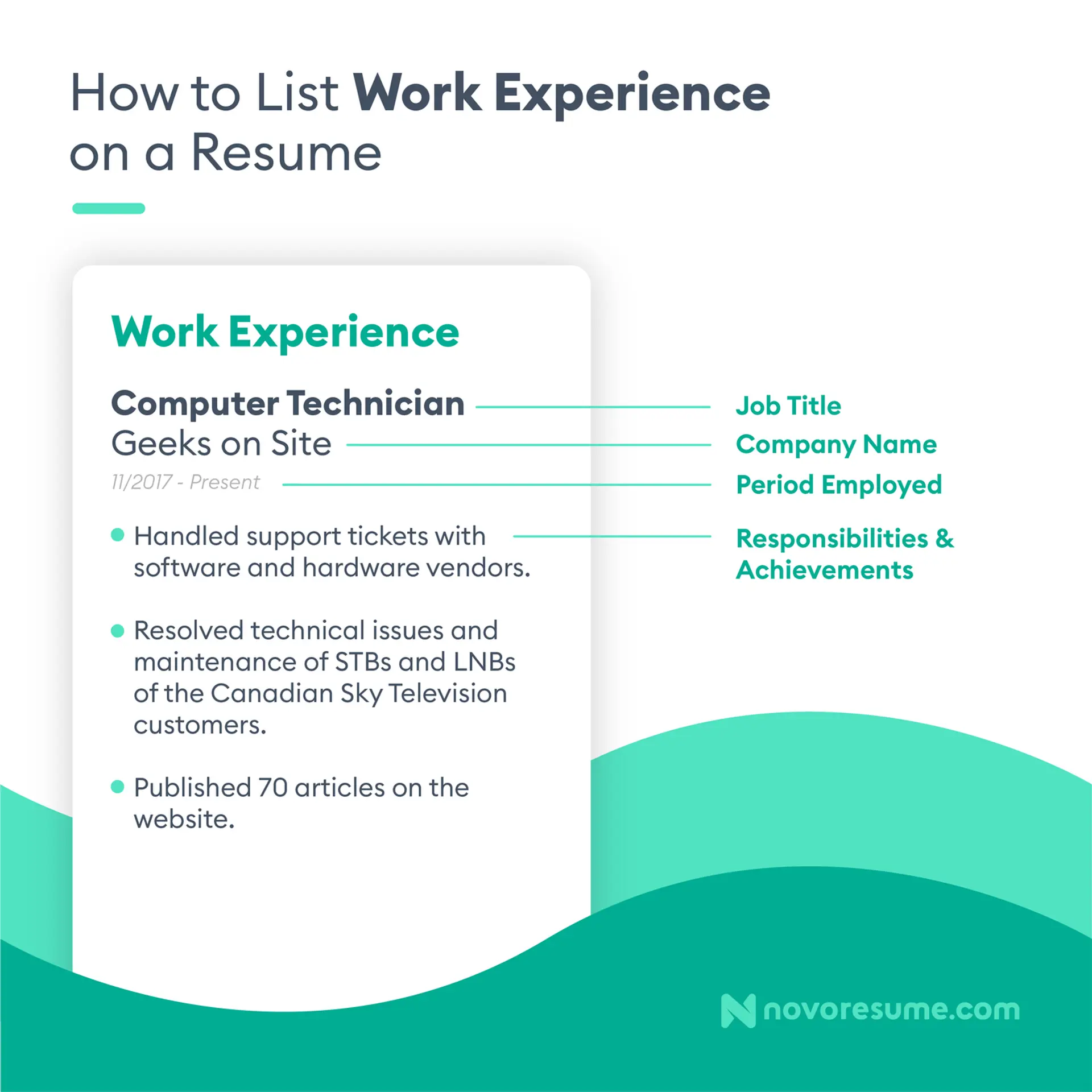
This should be right at the top so that anyone scanning your resume won’t miss it.
2. A short 1-2 sentence description explaining what the company does.
Certainly, if you have worked in a globally recognized brand like Apple, Google, McKinsey’s, etc, then you probably don’t need to include background information on the company.
Otherwise, add the company’s name, location of the office where you worked, and a one-sentence description of what the company does.
3. Include 4-6 bullet points describing the core duties and activities you performed for the company.
Now, this is the tricky part - listing your work experience the right way.
Each bullet point here should be a one-sentence description of a duty or activity.
Most people, when writing their resume, simply list out their basic responsibilities.
Things like “Managed the sales at the company & dealing with clients” or “Marketed company products and drove sales.”
Well, here’s the thing. The hiring manager knows what your responsibilities are. What they want to know is how you drove results at the company and helped take it from point A to point B.
Here’s how a well-written achievements/duties/activities look like:
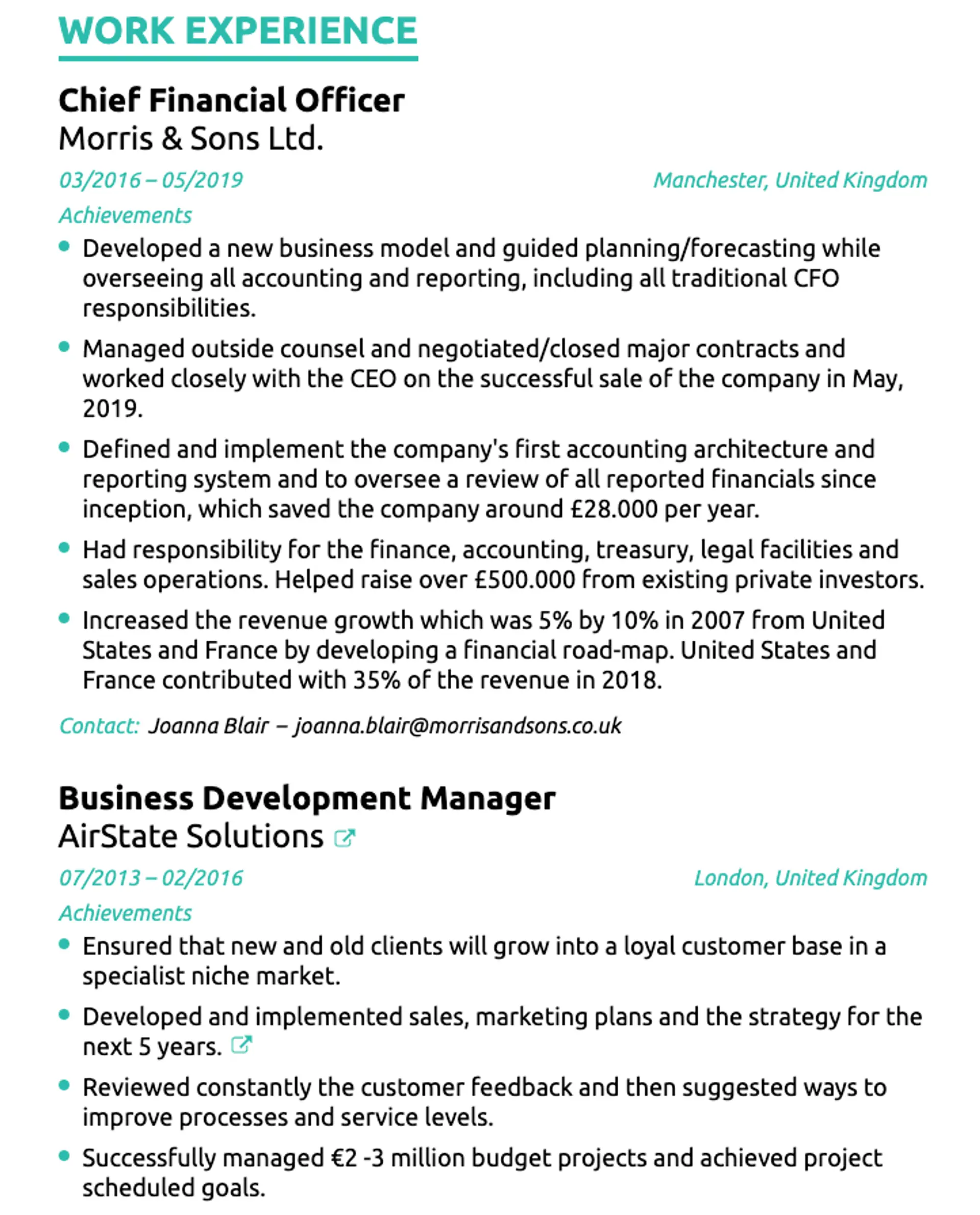
Describe your Achievements using Numbers and Percentages to Back Them Up
When possible, you should back up your achievements with numbers and percentages.
This is how you show the employer that you’re a high-achiever.
To show you how this looks in practice, let’s take an example of an achievement for a customer support agent:
“Increased customer support ticket closing satisfaction rate”
While this is definitely a good start, it doesn’t actually mean anything. Anyone could say they’ve done this - but there’s a huge difference between someone who increased the satisfaction rate by 0.5%, and by 30%.
What if you rephrased it as:
“Increased customer support ticket closing satisfaction rate from 47% to 72% within 3 months.”
Now, this is a lot more actionable. The hiring manager can see how good you are, and how you’d be an asset for the company.
In this case, it’s instantly clear that you know what you’re doing, and your resume goes directly to the YES pile.
Should You Include Internships on Your Resume?
If you just graduated, chances are that an internship (or internships) is the only relevant experience you have. So, definitely mention it in your resume.
If you have already worked for a few years, though, you can completely get rid of internships from your resume.
There are some exceptions to this rule, though. For example, if you did an internship at CERN (the particle reactor in Switzerland, one of the most renowned experimental physics institutes in the world), you would be better off keeping it.
4. What Skills Should You Put on a Resume to Make You Stand Out?
“Roughly 75% of large companies use an Applicant Tracking System (ATS). As a result, over 70% of resumes submitted to job-boards are never read.”
Luckily, getting past ATS is not that hard. All you have to do is mention the right skills in your resume.
By the right skills, we mean the skills asked for in the “requirements” or “qualifications” section of the job ad.
To figure out what they are for the position you’re applying for, simply go through the listing.
Let’s cover a real example to make this super clear.
Here’s a job listing for a UX/UI Designer position at XYZ Inc.:
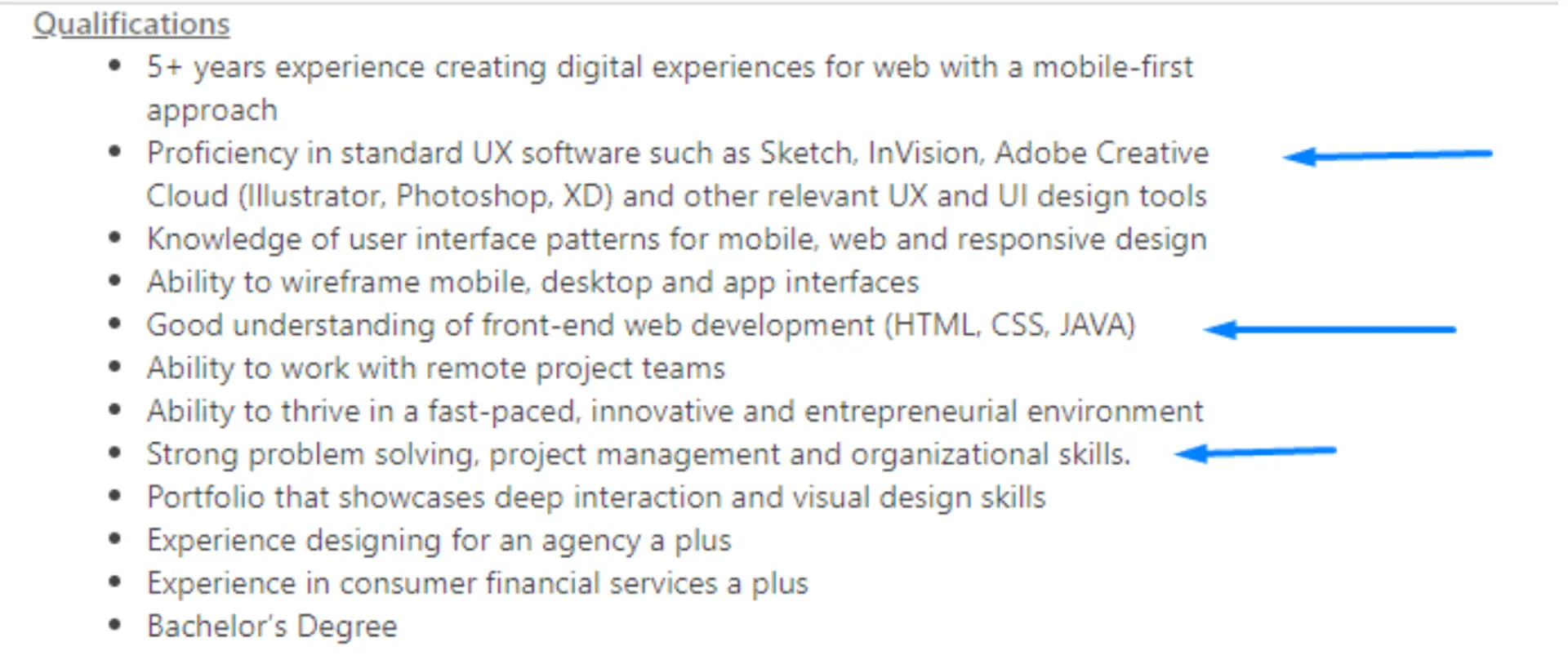
As you can see, the skills required for the position are:
- Proficiency in standard UX software such as Sketch, InVision, Adobe Creative Cloud (Illustrator, Photoshop, XD) and other relevant UX and UI design tools
- Good understanding of front-end web development (HTML, CSS, JAVA)
- Strong problem solving, project management and organizational skills.
Now, all you have to do is mention all of them individually in your resume Skills section.
Pro TIP:
NEVER lie on a resume about your skills’ experience level. Even if you do make it past the interviews and miraculously get the job, you’ll eventually be caught in the lie.
Hard Skills
Hard skills are the technical skills you pick at university or work. They can be measured, and are usually directly related to the tasks you complete at work
Think, anything from designing in Photoshop to using a specific ERP system.
Here’s how they’d look on your resume:
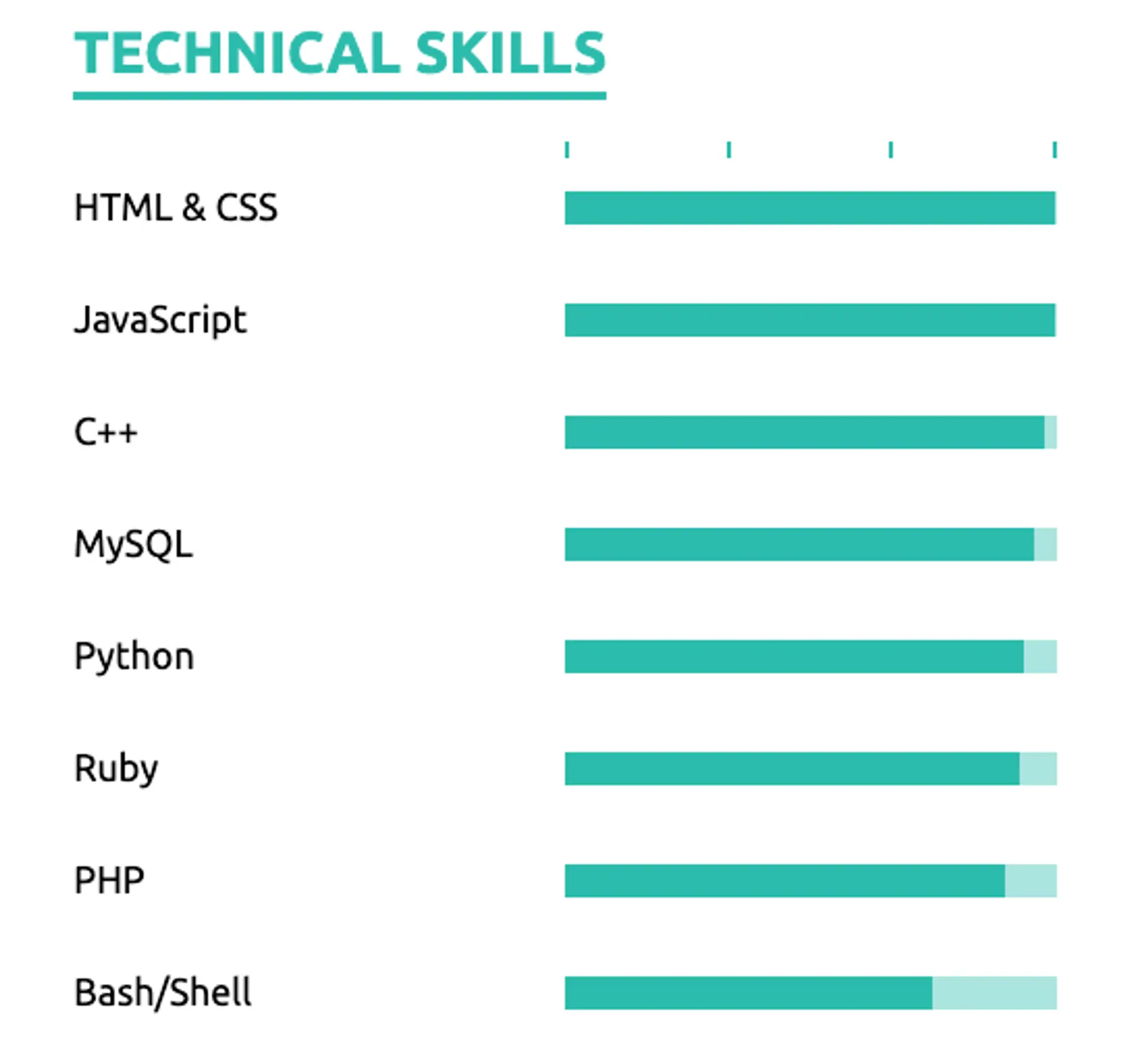
Looks neat right?
That’s not just it, though. To write a good Skills section, you should also mention some of your soft skills.
Not sure which skills to use? It might be one of these 100+ essential skills to put on any resume!
Soft Skills
While hard skills are learned technical skills, soft skills are your personal attributes.
Here are a few, just to give you a general idea:
- Leadership skills
- Strategic management and planning
- Research
- Teamwork
- Communication
And here’s how they look on your resume:

Pro TIP:
Your skills section should be backed up by your work experience. If you say that you’re an expert at Java, but you’ve never worked as a Java developer, no one’s going to buy it.
Universal Skills
As a rule of thumb, it’s a good idea to also put some universal skills on your resume.
What are universal skills?
They are skills that fit in the description or requirements of most career fields. Universal skills can be both soft and hard skills.
Some soft universal skills are leadership, teamwork, and analytical thinking.
Ms Word, Excel, Powerpoint, writing skills, etc... are typical hard universal skills.
Regardless of the job you are applying for, these are the skills that will come in handy at some point.
5. How to List Education on a Resume
Another essential part of your resume is the Education section. Here, you describe your academic career with any relevant achievements.
Here’s how you’d format your education section:

And here’s how this would look on a resume:

Keep in mind that you should mention your education in reverse-chronological order. So, the most recent thing goes on top.
When writing your education section, here’s a couple of things you should keep in mind:
- Don’t mention your high school degree if you have a university degree
- Mention your GPA only if it’s above 3.5. Anything below that might not seem too impressive (especially if you’re competing with someone who listed a 4.0)
- Mention your education before your work experience if you don’t have any work experience.
6. Other Important Sections to Put on a Resume
By this point, you have already done the heavy-duty work. The previous sections are the MUST-haves of a resume.
There are, however, several other sections you can mention on your resume that’ll help you land the job.
Certifications and Awards
Do you have any certifications or awards that are relevant to your field or career? Make sure to put them on your resume!
If you are a software developer or engineer, you could mention things like your Java or AWS certification.
Similarly, if you are applying for a Digital Marketing position, those Google Analytics and AdWords certifications would come in very handy.
Languages
In today’s world, languages are one of the top distinguishing hiring factors. Since most companies nowadays are international, knowing two or more languages can become a HUGE advantage.
Countless companies nowadays value bilingual employees more than those speaking only one language.
Whatever job you are applying for, make sure to include all the languages you speak on your resume. Include your proficiency level next to each one.
You can see in the example below the different phrases you can use to describe your language proficiency levels.
- Native or Bilingual
- Full Professional Proficiency
- Professional Working Proficiency
- Limited Working Proficiency
- Elementary Working Proficiency
Make sure not to lie about this. It's not hard to figure out when someone doesn't speak a language. Your “Full Professional Proficiency” Spanish might go “adios” all the way down to “Elementary” if the interviewer speaks the language.
Hobbies and Interests
The hobbies and interests section can help you convey a little bit of personality.
This is where you can show how big of an influence music is in your life. Or even reveal your Harry Potter addiction. Whatever it is, make sure you mention something that can really set you apart from the rest.
You never know, maybe you end up having a lot in common with whoever picks up your resume.
Volunteering Experience
Altruism and generosity are characteristics that will make you stand out regardless of the environment you find yourself in, the office included.
Hiring managers tend to prefer candidates who have some volunteering experience. This means that the employee is the type to spend their own free time on a worthy goal.
Chances are, the same dedication also transfers to the workplace.
If the volunteering experience is somehow related to your career, you can include it in the work experience section. Otherwise, you can create a separate section just for this.
Here’s how this would look like:
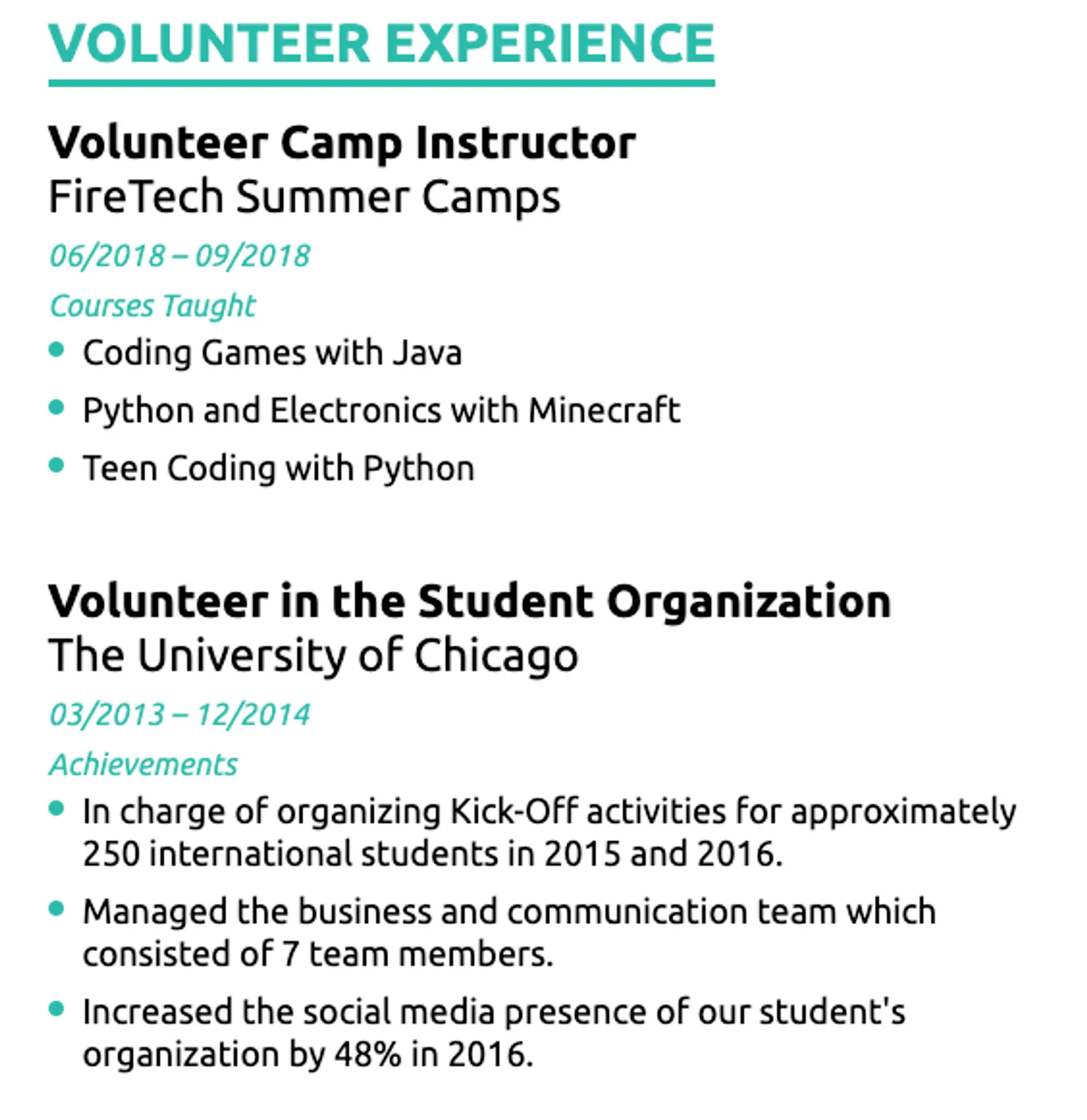
Publications
If you're a professional writer (i.e. journalist, researcher, scholar, etc.), you'd benefit from including your publications on the resume.
Maybe you have several blog posts published online, or a publication or two in an academic journal.
Whichever the case is, you can include them in your resume and make sure to mention the link.
Projects
Side projects are super important for many positions. They can help you make up for any lack of experience in a certain field, or display your passion for the job.
For example, if you are a developer or a coder, you must have a bunch of projects on Github. It could be a project you have done for a class or some app you started working on with your friends back in college (new Facebook, anyone?).
Projects aren’t just for coders, though. Maybe you attended a startup weekend at some point in your life? Or participated in a design hackathon?
Both of these examples can really add value to your application.
If you’re an entrepreneur, you can also mention some of your side hustles. Things like re-selling goods on eBay, selling your art on Etsy, and so on.
Next Steps: Tailoring Your Resume to the Job
Now that you know what sections to put on your resume, let's talk about its content.
It's essential that any information you've mentioned on your resume is relevant to the job.
We really can’t emphasize enough how important it is for you to check every section you have put on your resume and make sure each one is tailored to the job/position you are applying for.
Why?
Because the hiring manager wants the job seeker that's applying for THEIR position, not sending a mass application to 50+ different companies.
So, here’s how you’d tailor your resume to the job you’re applying for. As step #1, take a look at the job ad and identify top requirements and skills.
Let’s use the following ad as an example:
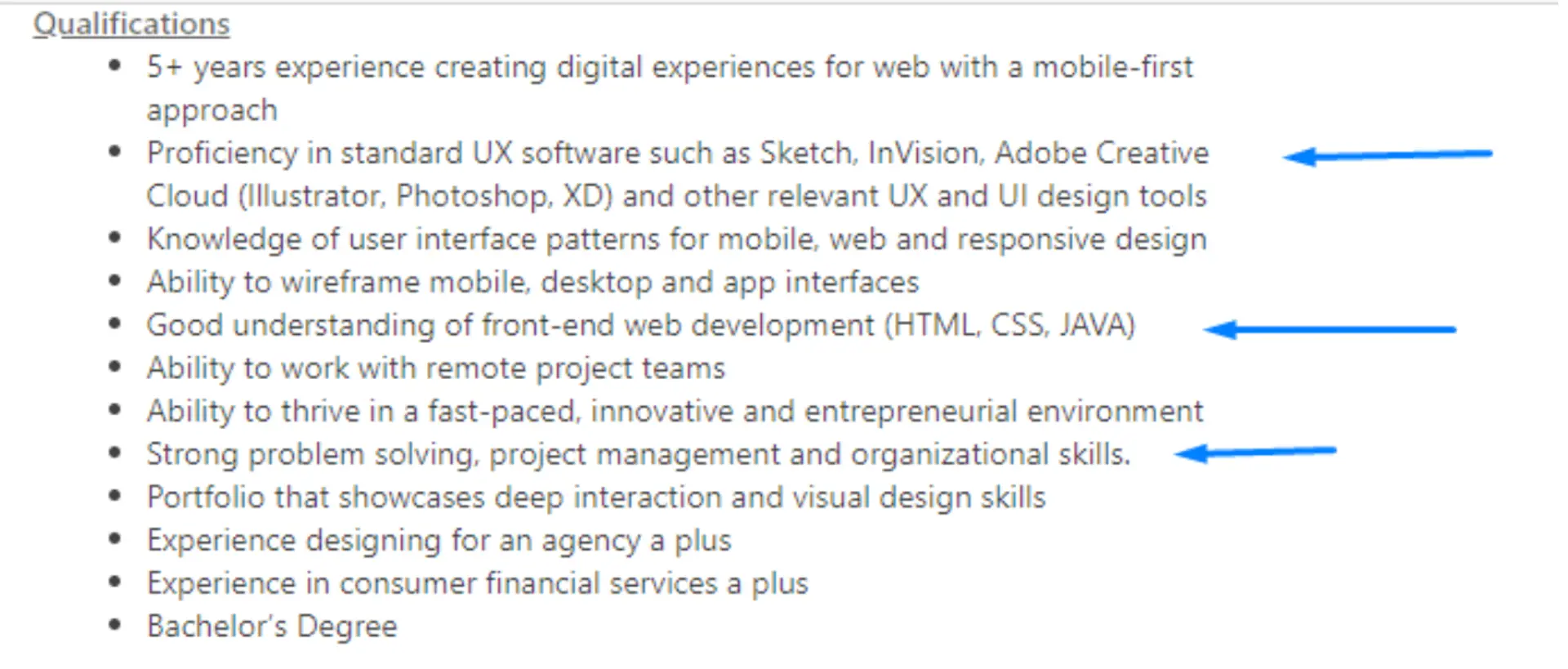
As you can see, the most important requirements are:
- 5+ years of experience in the field
- Skills in Copywriting, Photoshop, and email marketing
- Practical experience creating and optimizing landing pages
Now, you need to make sure you mention all of these in your resume, in whichever section they’re relevant.
Now that you know exactly what to put on a resume, we thought it would be helpful to also cover what NOT to put on a resume.
20+ Things You Should NOT Include in Your Resume
What NOT to Include in the Contact Info Section
- Date of Birth - Age should not matter to a hiring manager. It’s not important for their decision-making, and at worst, it might lead to age-based discrimination.
- An Unprofessional Email Address - Do: name.lastname@gmail.com Don’t: terminator91@gmail.com
- Photo - Especially in the US and in the UK (due to anti-discrimination laws). Hiring managers don’t need to know your appearance to evaluate your resume and application overall.
- Your exact address - very few businesses use mailing services nowadays to communicate with potential hires. It’s inefficient, and it’s simply safer to use your email.
What NOT to Include in the Resume Summary or Objective Section
- If you have a few years of related work experience, then you should not include a resume objective.
- Your resume summary or objective should also not include any requests, demands, or salary requirements.
What NOT to Put in the Work Experience Section
- Jobs that aren’t even remotely relevant to the position you are applying for. No one cares about your experience as a cashier if you’re applying for a designer gig
- Fluff that doesn’t say anything. This is a lot more common than you’d think. Make sure all your duties and activities listed are practical
- Jobs that you had for a short time period (a few weeks). This shows that you’re a job hopper and unlikely to stick around for job (even if the employer you quit on was horrible).
- Any illegal jobs
What NOT to Add to the Skills Section
- Irrelevant skills to the job in question
- Fluff skills just to take up space. Fun fact - a TON of university students fill up their resume with buzzwords like “Leadership, Critical Thinking” and so on.
What NOT to Include in the Education Section
- Your GPA (if it’s lower than 3.5)
- Your high school degree (if you have a university degree)
- The entire list of all the courses you attended in college
Others
- Hobbies related to controversial topics (politics, religion, sex) based on ideologies and cultural differences. You can never know if the person reading your resume is on the same page as you.
- Childhood hobbies. Sure, you were a great football player in high school. But how relevant is it for that junior accounting position you are applying to?
- Irrelevant projects and publications.
Key Takeaways - What to Put on a Resume
Now that we’ve covered all the sections & contents you need to put on a resume, let’s summarize everything we’ve learned:
- The core contents of a resume include: contact information, resume summary / resume objective, work experience, education and skills.
- The optional sections are: certifications & awards, languages, hobbies & interests, volunteering experience, publications, and projects.
- Make sure to make your work experience section shine by talking about results & achievements, instead of dull responsibilities
- Lastly, you should tailor your resume to each different job you apply for!
At Novorésumé, we’re committed to helping you get the job you deserve, every step of the way! Follow our career blog to stay up to date with the industry-leading advice. Or, check out some of our top guides:
